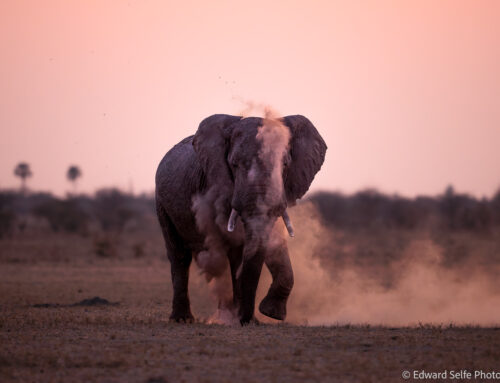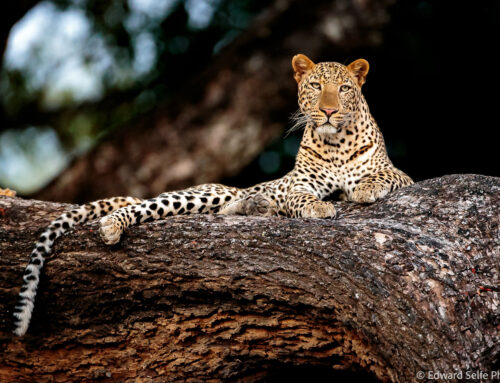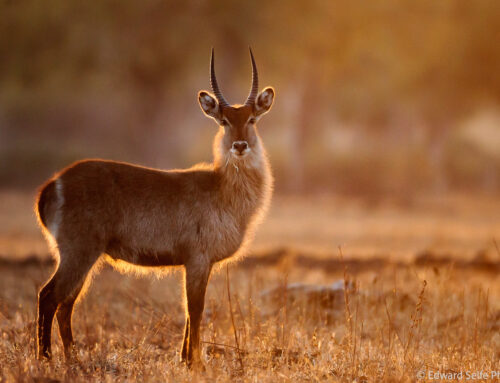People travel from across the world to enjoy Africa’s finest wildlife reserves. These wild areas are as diverse as they are numerous, supporting an extraordinary wealth of life from mega-mammals to colourful birds and incredible insects. But perhaps nothing inspires more excitement than the joy of tracking down and viewing a leopard, Africa’s most beautiful predator.
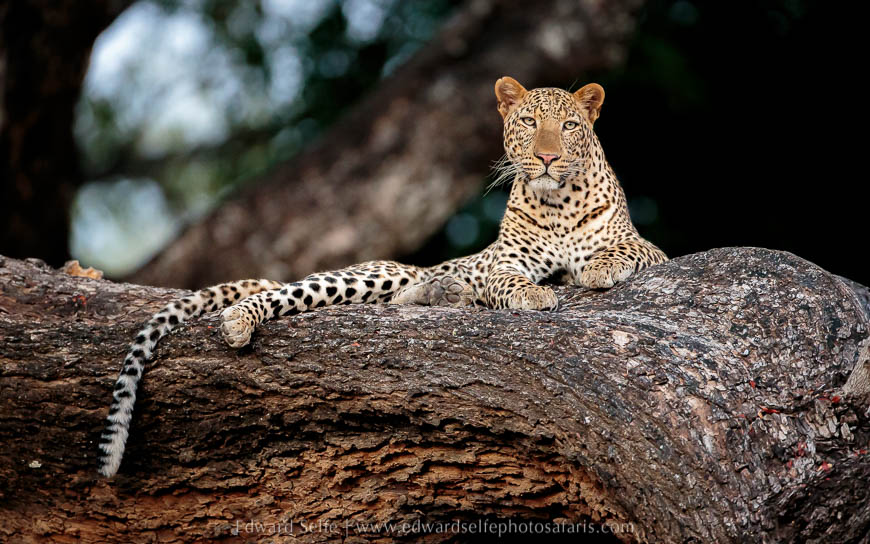
My encounters with leopards usually begin with a feeling; I tend to notice the subtle behaviour of other animals which will give away the presence of a nearby spotted hunter. Perhaps it’s the raised heads of feeding antelope combined with the single alarm-bark of a distant baboon.
I then listen for the calls of smaller creatures – which are equally fearful of leopards, even if they don’t have the ability to shout so loudly – to pin-point the cat’s location; maybe it’s the subtle “tuk-tuk-tuk” of a francolin, or the shrill descending call of a squirrel or even the quiet but insistent cacophony of finches and bulbuls as the leopard moves through thick bush …. whatever signs the bush gives, when we eventually track down our leopard, excitement levels will be pretty high!
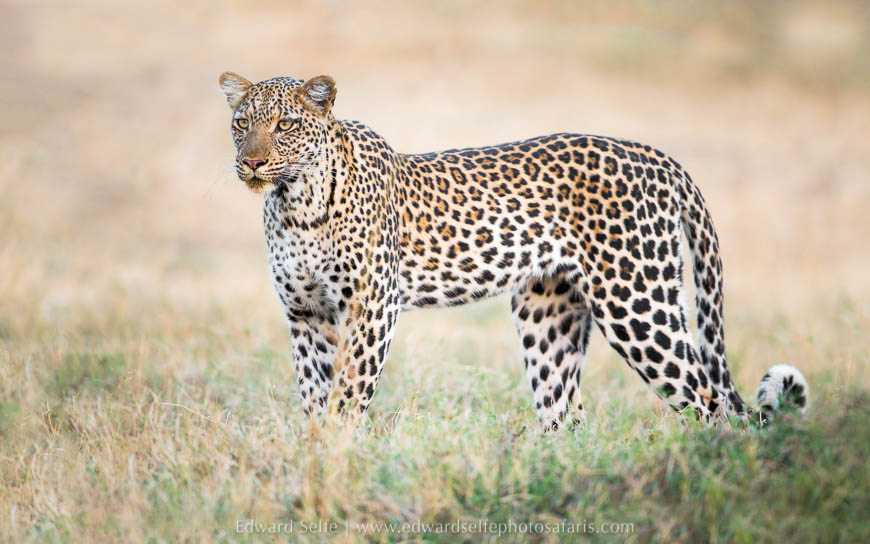
The South Luangwa is well known for outstanding leopard sightings, something that I can certainly verify after nearly 10 years guiding here! So, once you have tracked down your Luangwa leopard with all the associated excitement, how do we ensure to make the best of the photographic opportunities? Here are 5 ways to improve your chances of getting excellent images of leopards on your next trip to the South Luangwa:
1. Less is More
It can be very tempting to point your camera at your subject and blast away, taking frame after frame of similar images. We’ve all done that! But, to get the best photos, you’ll have prepared your camera in advance for the lighting levels and you’ll take some time to compose your images, rather than simply keeping the leopard in the middle of the frame. It will also be beneficial to take your eye away from the viewfinder and review your images on the camera’s screen; this will reveal if your shots are sharp and correctly exposed.
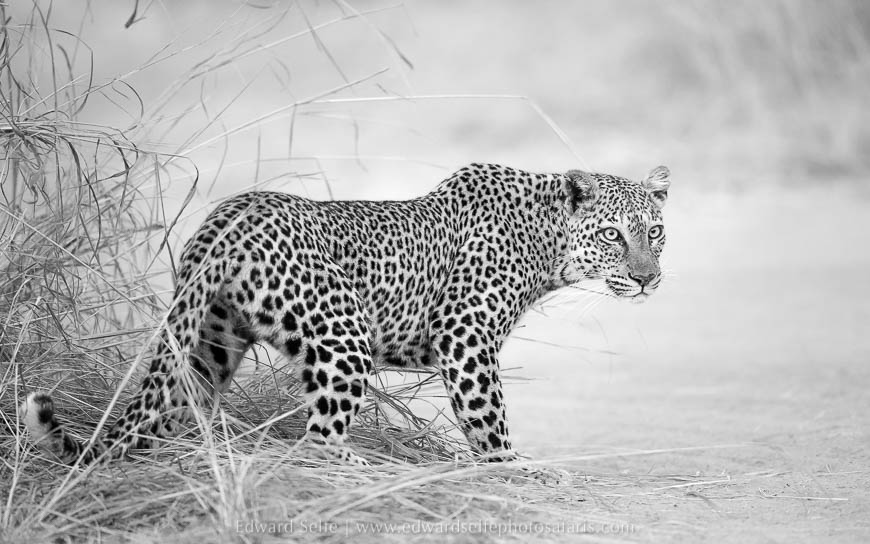
In the same way that fewer photos are often better than more, planning ahead and choosing which scenarios to photograph at each sighting will also help. When the leopard moves through long grass, rather than tracking it from behind or from the side, try to predict where it will re-appear and position yourself for its arrival. In this way, you are giving up your current view and gambling on a better view a few moments ahead. In the heat of the moment, this is a hard gamble to take, but predicting what will happen next is the way to create images, rather than just taking them.
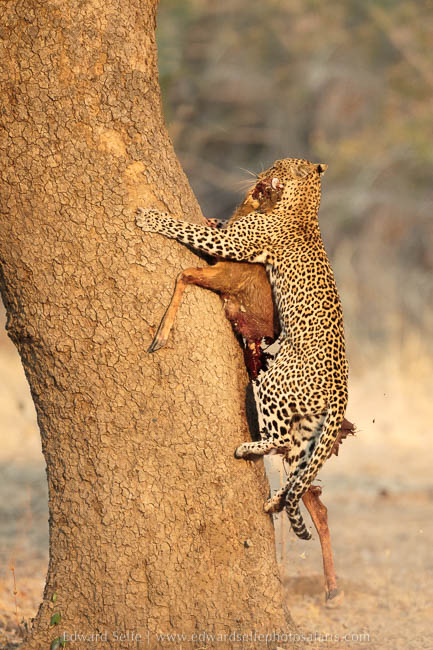
Taking a moment to review your images will also slow you down and give you perspective. Do you need any more images of that leopard in that setting? If you’ve nailed your shot, you can start to watch the leopard’s movements and add shots with behavioural value to your set. Leopards often swish their tails when they walk, so you could track the cat and take a burst of shots when the cat lifts its tail high over its head. They are sometimes bothered by flies too, choosing to snarl or snap at them as they walk which can make an interesting shot. But the key lesson here is to slow down and observe your subject, taking time to choose your moments.
2. Get Low
Leopards are small cats; standing around 50-60cms at the shoulder. But this small size belies their astonishing strength and presence. The best way to convey this is to photograph them from their level or below. It’s not always easy to achieve this from the back of a safari vehicle, but it’s possible by planning ahead and giving up the current scenario to enjoy a better one. You might gamble and move ahead to position yourself in a gully where the leopard might stalk antelope. The Luangwa valley floor is covered in such channels offering great hunting grounds for leopards. Stopping in the gully will give you a very low angle as the leopard approaches you; one or two good shots from this low position will replace hundreds taken from higher up. You can achieve a similar effect by watching for when a leopard’s path might take it up a termite mound, leaving you with a superb photographic angle.
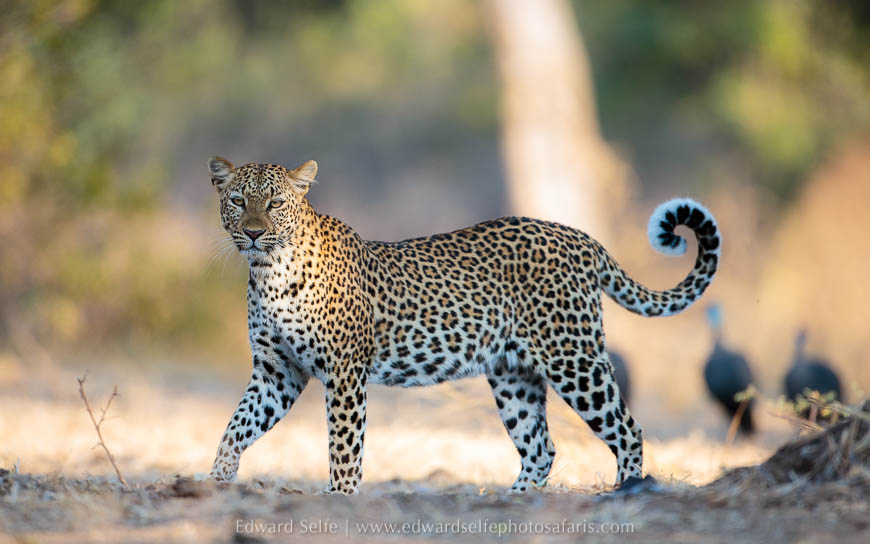
You can also improve your photos by not driving too close to your subject; this may sound counter-intuitive but there are two very good reasons. Firstly, giving your subject space will more readily result in natural and interesting behaviour, which is then visible in your images. Cats which are disturbed, even if not in a serious way, will often lay their ears back on their heads; a cat with its ears forward makes a more pleasing shot.
Secondly, keeping your distance will ensure that you are looking “across” at your subject rather than down on it. You will also need to use your longer telephoto lens, or zoom your lens to a longer focal length, which will reduce your depth of field and give the impression of a lower angle of view. Compare the following two images where the leopard is a similar size in the frame but the second image was taken at a longer focal length.
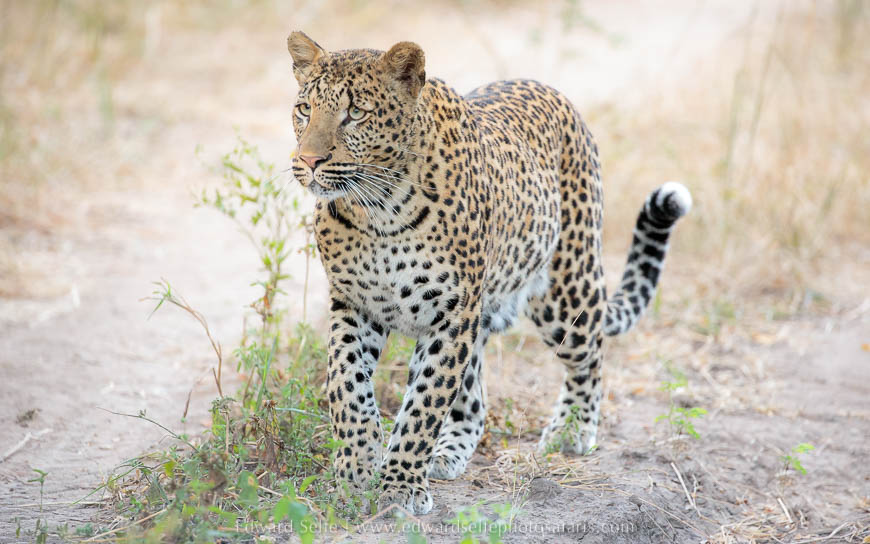
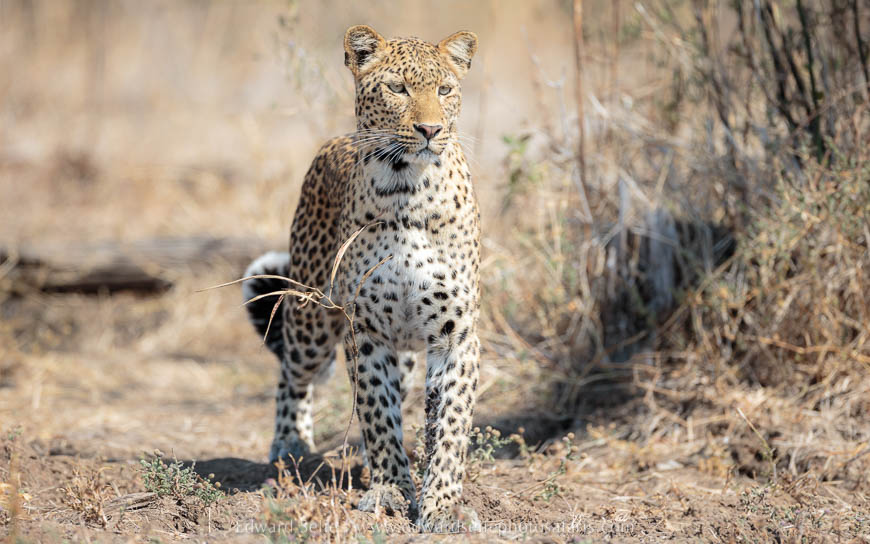
3. Night time
The South Luangwa is famous daytime sightings of leopards which choose the early morning and late evening to hunt without the presence of scavengers such as hyaenas and lions. However, the Luangwa is also unusual because night drives are allowed, so it’s still likely that a number of your leopard sightings will be in the dark. Photographing a moving subject in low light with a long lens is a tricky challenge even for skilled photographers with professional kit, but it’s possible to get good photos with a spotlight by following a few guidelines. At sundowner time, change your camera settings as follows:
a) Choose Aperture mode and set your lens’s aperture to its widest setting. The aperture is indicated on the camera body by a number such as f5.6, f4 or f2.8. Choose the lowest number. This will allow the most amount of light into your camera.
b) Set the ISO to a high sensitivity setting. The ISO will be indicated by a number such as 800, 1600 or 3200. For night time photography with a spotlight, you will need ISO 3200 or 6400 if possible.
c) Change your metering mode to Spot metering. The metering mode will usually be indicated by a box (representing the frame) with different markings inside it. Choosing spot metering will tell the camera to measure the light levels and expose only for the central area of the scene.
These settings will allow the most amount of light to hit the sensor, and tell the camera to make the very best use of that light and to ignore the large areas of black outside the lighted area that the spotlight creates. This will give you the best chance of getting sharp images during your night safari.
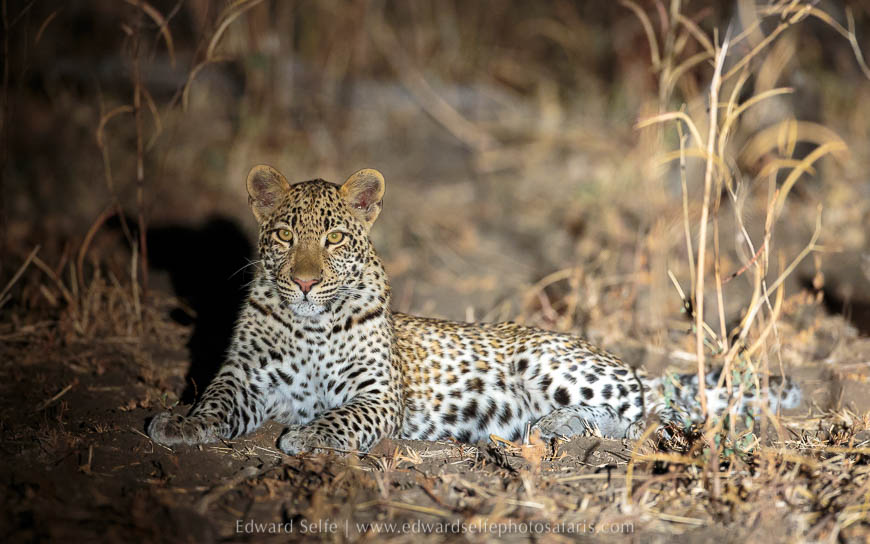
Thereafter, you can take images knowing that you have given your camera the best instructions for photographing at night. Given that getting sharp images – without movement blur – will be your biggest challenge, you should choose your moment, and take shots when the leopard pauses to scent or scent mark a tree or bush.
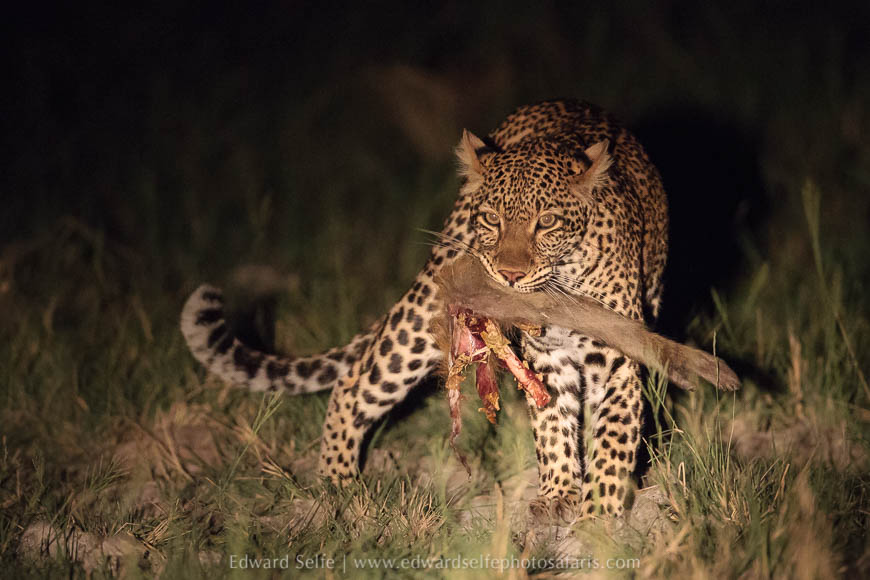
If you are feeling creative, and the area where you are on safari has more than one vehicle out at the same time, you can try using the light from the other vehicle’s spotlight to illuminate the leopard. Turn off your own spotlight, use the other vehicle’s spotlight and the same camera settings as above. Wait for the leopard to stop moving for best results.
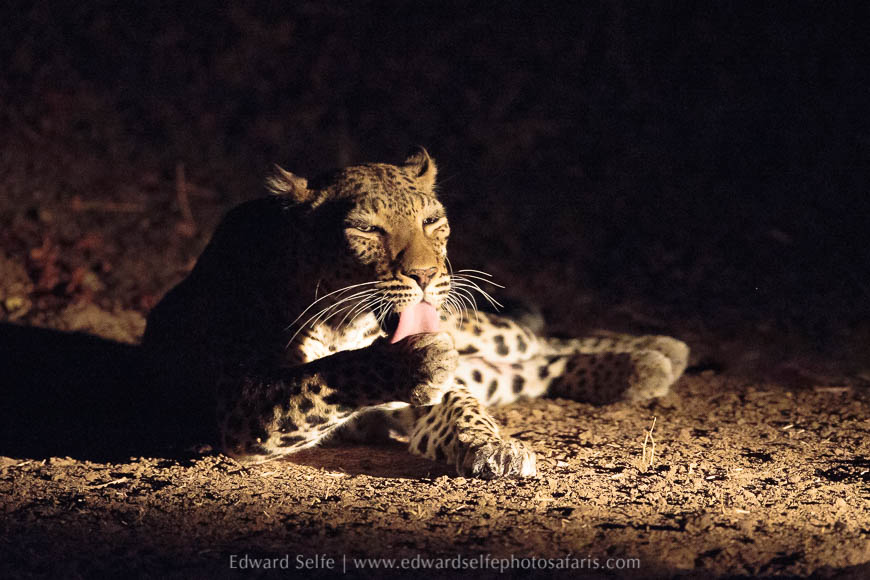
Don’t forget to change your camera back to your preferred settings before you start your next safari in the morning!
4. Leopards in Trees
A leopard in a tree is highest on most photographers’ safari wish-list. The Luangwa’s rich prey zones, combined with mature trees and a strong pressure from scavengers means that leopards in this area regularly take to the trees to protect themselves, their cubs and their prey.
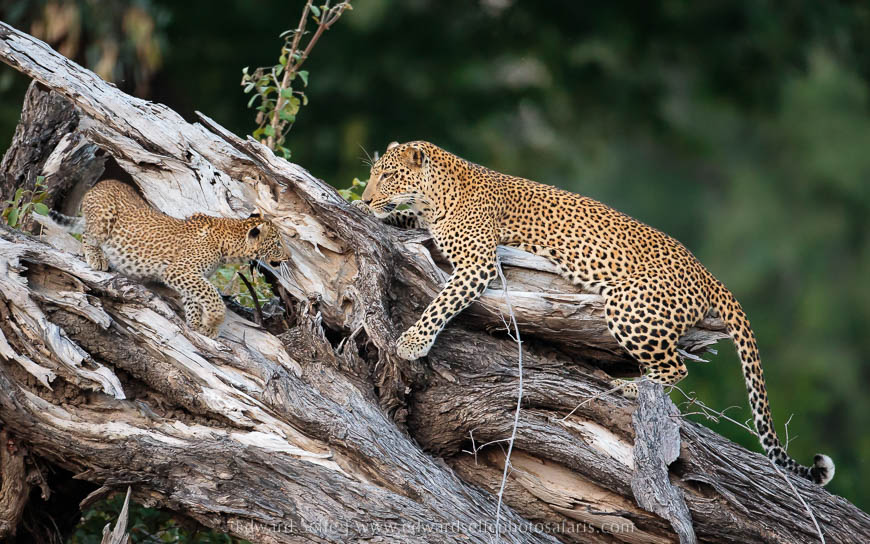
Once a leopard reaches the branches of a tree, they usually feel safe from predators on the ground and don’t hide behind the foliage. But vegetation that conceals the subject can still be a problem if it distracts the viewer. Try to get a clear view, at least of the leopard’s eyes, and then work on choosing an exact spot which reduces the amount of bright light coming through from the background. These bright spots confuse the camera’s meter and often result in images that are too dark.
If there is foliage covering part of the leopard’s body or face and it can’t be avoided, try to use it to your advantage. Some of the best shots of leopards display their secretive tendencies by partly concealing them among the thick bush that provides them with cover. Try placing bright green leaves in front of the cat, and enjoy the way the green contrasts with the orange of its coat.
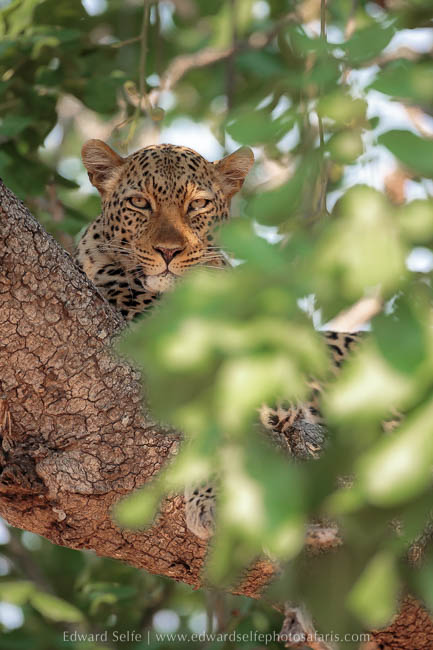
If your subject is too dark when you check your camera’s screen, it may be because light is coming through the leaves of the tree from behind your subject. In this case, you will need to tell your camera to over-expose the image to compensate. On many dSLRs you can do this readily with a wheel or a dial marked with a +/- indicator as it is a regularly-used adjustment. Change the setting so that +2/3 or + 1 is showing, and the repeat your shot, adjusting further if necessary.
5. Hunting
A leopard on the hunt is one of Nature’s finest sights. To watch the patience, caution and intense concentration is extraordinary; and when the ambush comes, the power and devastating precision are very humbling. If you are lucky enough to enjoy one of Luangwa’s leopards on the hunt, apply all the same photographic principles that we discussed in sections 1 & 2 above, but keep in mind that you are responsible for the outcome of a situation that affects the lives of both the hunter and the prey.
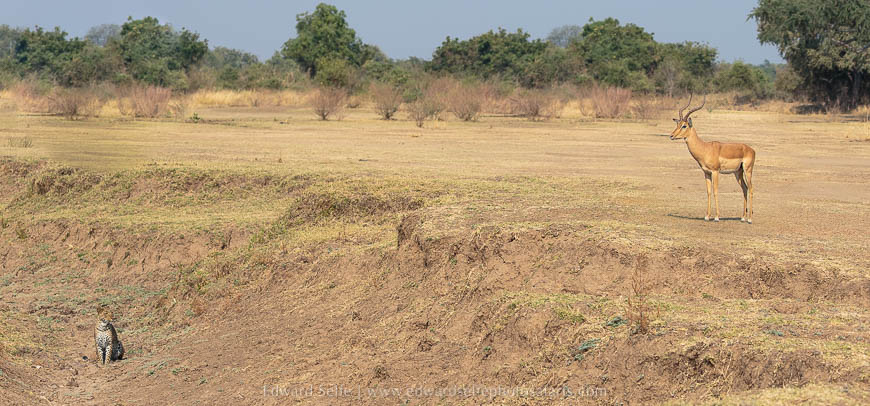
Take care not to allow your drive to achieve the best images to impact your judgement. Position yourself with a view of the action, but keep in mind that you can easily move closer after the kill has been made, but if you move too early, you might prevent the hunt occurring.
The strike speed of a leopard is unbelievably fast. You may be able to track it with your eyes, but you’ll likely struggle to keep up with your camera. So, if the ambush is imminent, I would suggest training your camera on the prey animal, rather than on the leopard. When the cat strikes, you will already have your camera set up to capture the moments as the predator appears in the frame and – perhaps – catches its prey. You’ll also be ready for any struggle that occurs. If you have your camera pointed at the leopard during the ambush, you might get one or two images as it explodes out of your frame, but you’ll miss most of the action!
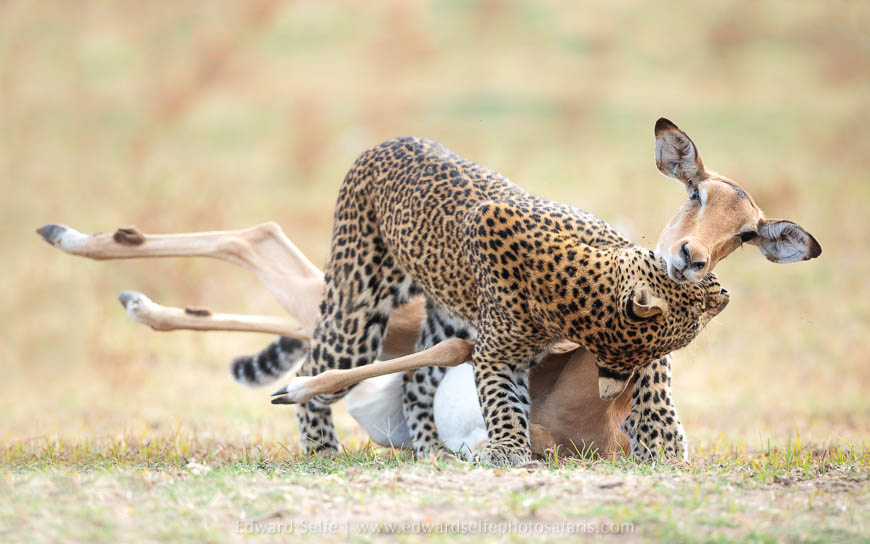
Unlike with most leopard activity which is slow and considered, you will need a very high shutter speed for the moment of a successful hunt. If the light allows, you should aim for upwards of 1/2000 sec to get the best chance of freezing the movement.
If you would like to discuss photographing leopards or anything about the Luangwa in general, please contact me using the links below. Good luck and enjoy your photography.
For more information on some of the concepts in this article, have a read of articles on setting up your camera for safari, using metering modes for night time photography, adjusting exposure compensation and an article on Luangwa’s leopards.
The South Luangwa offers some of the finest leopard encounters on the planet. But it is also a stunningly beautiful river valley with mature woodland, open grasslands, floodplains with drainage channels and mopane forests, threaded throughout with large lagoons. Few safari destinations offer better opportunities for photographing Africa’s headline species against a background that is as interesting, beautiful and diverse as the subjects themselves.

